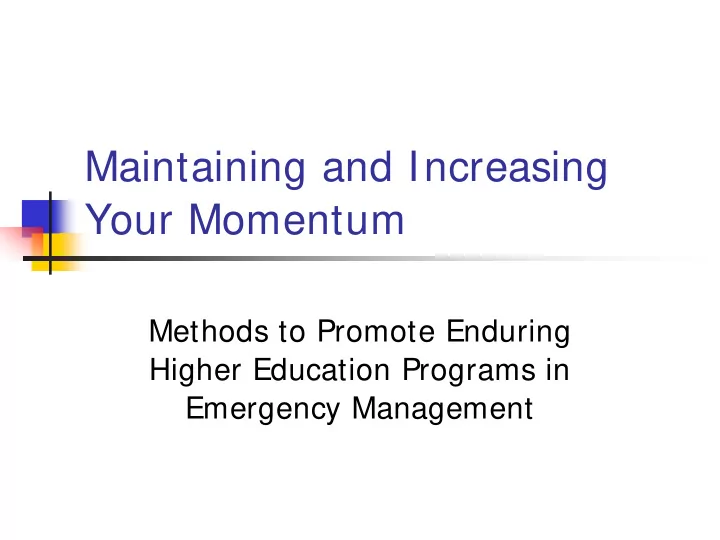

Maintaining and Increasing Your Momentum Methods to Promote Enduring Higher Education Programs in Emergency Management
The Importance of Education � The challenge of disasters � Increased vulnerability and losses � Need for professionals in the field
History of the EADP Program � An outgrowth of North Texas State University continuing education for FEMA � Proposed as an academic degree in 1983 � Became fully operational in 1984 � The first to offer a Bachelor of Science in the field
History of the Program (cont.) � Originally taught from a practitioner’s viewpoint � Developed a strong academic orientation in the mid 1990s
EADP Student Base � Historically made up of predominantly male practitioners seeking a career change or additional credentials and qualifications � Now includes more traditional, pre- career male and female students
EADP Graduates Local and FEMA Other Federal State Agencies (EPA, Emergency OFDA, etc.) Offices Foreign American Red Industrial Governments Cross Facilities Business Transportation Other Continuity Companies Firms
Program Challenges � Student recruitment � Acquiring information resources � Integrating theoretical and applied perspectives � Providing the “big” picture � Helping students specialize in the field � Apathy, administration and awareness � Faculty shortages � Program location � Future opportunities
Student Recruitment � Develop a logo � Produce a brochure � Send out an information kit � Generate a newsletter � Create a website � Offer a “draw in” course � Provide social activities � Acquire scholarship funds � Maintain contact with degree advisors � Improve course content, instruction and rigor
Information Resources � Request FEMA/state/Red Cross training materials � Acquire FEMA’s higher education courses � Obtain documents from local jurisdictions � Order books for the library � Subscribe to academic and professional journals
Providing a Strong Theoretical Foundation � Origins of the field (Sociology of Disaster, DRC research, etc.) � Definitions of hazards, disasters, vulnerability � Goals of emergency management � Four phases of emergency management � Three sectors of emergency management � Twin foundations of emergency management � New concepts
The Need for an Applied Approach � Would you want a doctor to operate on you who only had book knowledge? � Emergency management is a technical field � Students desire both theory and practical application � Prospective employers want graduates who will contribute without extensive training
Complementing Theory With: � Guest speakers � Field Trips � Practical knowledge, skills and abilities � Student presentations � Group projects � Internships
Providing the “Big” Picture � Required courses � Geography or Geology � Technical Writing � Interpersonal Communications or Public Speaking � Introduction to Emergency Management � Mitigation/Preparedness � Response/Recovery � Leadership and Organizational Behavior � Financial Aspects of Government � Capstone in Emergency Management � Practicum � How to structure curriculum?
Specialization � Elective courses � Images of Disasters, Hazardous Materials, Special Populations, Computers in EM, International Disasters, Private Sector Issues, Flood Plain Management, Federal Government and Disasters, Terrorism and EM, Public Health and Disasters, Public Administration, Public Management, American Intergovernmental Relations, Public Policy Analysis, Meteorology, Introduction to GIS, Risk Management, Workplace Health and Safety, Collective Behavior, Sociology of Disaster � Minor
Apathy, Administration and Awareness � Educate faculty and administrators about emergency management � Seek accreditation � Establish an advisory board � Develop a student handbook � Hold new student orientations � Create IEMSA and Rho Epsilon Mu chapters � Sponsor conferences � Show me the money!
Faculty Shortages � The current context � Growth of programs � Limited faculty in the field � Interest among students � Implications
Program Location � Logical choices of Sociology, Geography and Public Administration � Could be housed anywhere � Stand alone programs � Interdisciplinary programs � Advantages and disadvantages
Future Opportunities � Expand into the private and non-profit sectors � Focus on the internationalization of the profession � Integrate technological applications into the degree � Augment focus on proactive approaches � Move toward multi-disciplinary perspectives � Develop student portfolios � Obtain external funding � Increase ties and networking with practitioners
Questions David A. McEntire mcentire@unt.edu (940) 565-2996
Recommend
More recommend